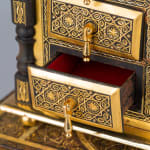Damascened Jewellery Case, 19th Century CE
height 19.5 cm
height 7 5/8 in
height 7 5/8 in
CB.3100
Further images
Damascening is the art of inlaying different metals into one another —typically, gold or silver are inlaid into a darkly oxidized steel background—to produce intricate patterns, much similar to the...
Damascening is the art of inlaying different metals into one another —typically, gold or silver are inlaid into a darkly oxidized steel background—to produce intricate patterns, much similar to the technique of niello. The English term derives from a perceived resemblance to the rich tapestry patterns of damask silk. The technique of niello -a black mixture of copper, silver, and lead sulphides, used as an inlay on engraved or etched metal- has been attested in prehistoric Greece, with the earliest occurrence of damascening in the Aegean being a dagger from the Shaft Graves of Mycenae, dating to the latest Middle Bronze Age/Middle Helladic IIIB period (2000 BC. ca). Cities that are known for a rich history in Damascening and in which the art is still practiced are Malaysia, Indonesia, Toledo in Spain, Eibar in the Basque Country and Kyoto in Japan. The art of Damascening arrived to Toledo directly from Damascus and developed a very important industry around this craft, also known as Toledo Gold. The art of damascene has passed from generation to generation within the same family for centuries, and has become a hallmark of the city.
Jewellery case in the form of a miniature cabinet on stand, the cabinet being furnished with a chest of six drawers. Although damascening is a term which sometimes is applied to the production of damask steel, it is properly the art of incrusting wire of gold (and sometimes wire of silver or of copper) on the surface of iron, steel or bronze. The surface upon which the pattern is to be traced is finely undercut with a sharp instrument, and the gold thread is forced into by hammering and is securely held by the minute furrows of the cut surface.
Jewellery case in the form of a miniature cabinet on stand, the cabinet being furnished with a chest of six drawers. Although damascening is a term which sometimes is applied to the production of damask steel, it is properly the art of incrusting wire of gold (and sometimes wire of silver or of copper) on the surface of iron, steel or bronze. The surface upon which the pattern is to be traced is finely undercut with a sharp instrument, and the gold thread is forced into by hammering and is securely held by the minute furrows of the cut surface.











